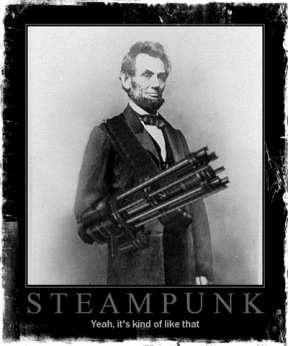On the punkery of steam
This was an article I was asked to write for a college mag recently, asking me for a writer's perspective on the steampunk genre. It borrows a little from my spittle-flecked 6 Part History of Steampunk series, found here. I don't know why I'm considered an expert when there are folks that have been doing it far longer than me. Maybe I just charge less than the famous folks.
Anyways, enjoy.
Before I start dribbling about steampunk from an author's perspective, I should probably define what I think steampunk is. This is more dangerous than it sounds.
The debate about what IS and IS NOT steampunk has kicked off many a flame war in various poorly-lit alleys of the internet, not to mention several drunken punch-ups at Conventions That Shall Not Be Named. When people try to explain steampunk, you'll see lots of vague hand-waving, and hear odd, slightly masturbatory terms like – 'retro-futurism' and 'neo-Victorianism' and 'techo-romanticism' being splashed about like cheap hooch at an Irish wedding. (I'm Irish, before you get offended)
But yes. Lots of 'isms', basically.
Some people will tell you steampunk should be set in Victorian times. Some people will tell you in should be set in England, preferably London. Some people will tell you there should be an inexplicable amount of tea-drinking and corsetry. Everyone should be well mannered and everyone should be wearing goggles, even in the shower or making sweet, sweet love to the beautiful heiress on the floor of the aether-bot workshop, an artful smudge of grease arranged on her heaving… Yes, well…
As far as I'm concerned there are four mandatories:
The book needs to be set in the past (otherwise you're writing science-fiction).
The setting needs to be industrialized (otherwise you're writing fantasy).
There needs to be some kind of advanced technology that you wouldn't normally expect to find in the setting (otherwise you're writing historical fiction).
You should be having fun (otherwise, what's the point)
SO, this is my definition of steampunk, in so far as writer-types and readers goes:
Steampunk (noun): A sub-genre of soft science fiction, typically set in an industrialized historical period, in which anachronistic technology is present.
The pre-conceptions with steampunk harken back to its roots – the 'scientific romances' of HG Wells and Edgar Rice Burroughs and the man who would NEVER have to buy his own drinks at a Steampunk con, Mr Jules Verne. These authors took us on fantastic voyages to other worlds and other times, often with the aid of fantastical technologies beyond imagination, in settings that were almost exclusively British donchewnoe (hence the bias towards English settings in the genre).
Funny thing is, even though many folks look back at these writers as the fathers of the steampunk genre, they weren't writing anything close to steampunk at all – in their day, they were writing contemporary fiction. It's only because the works survived for close to 150 years in our collective consciousness that the label steampunk can be applied after the fact.
The real origins of steampunk fiction lie in the works of authors like KW Jeter, Tim Powers, James Blaylock and the father of cyberpunk, Mr William Gibson (all hail). Though Jeter coined the term 'steampunk', it was probably Gibson who gave it life, funnily enough whilst praying aloud that the label didn't get applied to his book THE DIFFERENCE ENGINE:
"I'll be happy just as long as they don't label this one. There's been some dire talk of 'steampunk' but I don't think it's going to stick."
Ironically, Gibson's statement probably did more to immortalize the term than anything before it. Such is his powah. Fear him.
Truth is, I think the attempt to codify and catalogue the IS and IS NOT of steampunk is the work of demon crack babies and Illuminati robots programmed to take all the fun out of life. The cool thing about the genre is that it's still relatively unexplored and undefined. The most successful writers in the genre are those who've taken the few accepted tropes and turned them on their heads. Cherie Priest's Clockwork Century series was set in the colonial west of America and threw in some zombie survival horror to boot. Scott Westerfeld's Leviathan series was half traditional Steampunk, half OTT fantasy with flying whales and genetically engineered war bears. For my part (you didn't think you'd make it through this without hearing a plug, did you?) I set my story in feudal Japan and combined some traditional fantasy with combustion-driven technology and it's called STORMDANCER and it's out on MacMillan in the US/UK and AUS in September 2012 and oh my god I need to pay my mortgage if you buy a copy it will really help me out and plug, plug, plugplugplugpluuuuuuuuug.
The good news for writers who feel like playing in the steampunk sandbox is that it's seen as a reasonably hawt commodity by major publishers right now. Westerfeld's series hit the NYT bestseller list and everyone involved drove home in a limousine, but there hasn't been a book that simply broke the genre and led to a market-saturating glut of clone works (like say, that book that shall not be named but starts with 'T' did for paranormal romance and vampires). So there's still some fun to be had before the ship inevitably sails.
Which is, after all, what steampunk is really all about.












